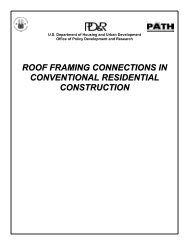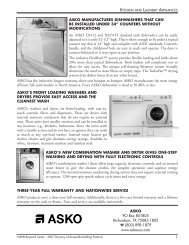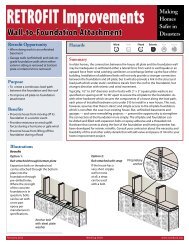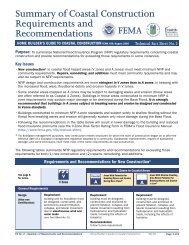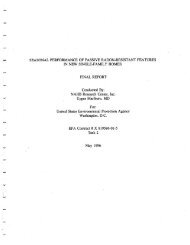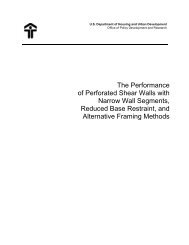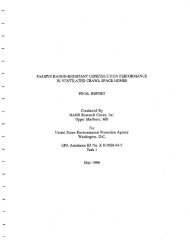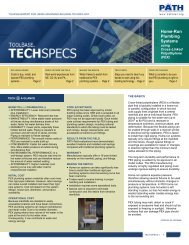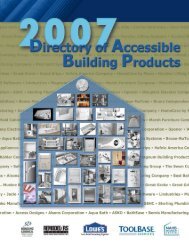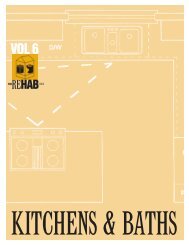The Rehab Guide, Volume 2: Exterior Walls - ToolBase Services
The Rehab Guide, Volume 2: Exterior Walls - ToolBase Services
The Rehab Guide, Volume 2: Exterior Walls - ToolBase Services
You also want an ePaper? Increase the reach of your titles
YUMPU automatically turns print PDFs into web optimized ePapers that Google loves.
acid. Efflorescence can often be removed by dry brushing, with pressurized water, or with proprietarycleaners. Dirt can be removed with water or with a detergent solution such as trisodium phosphate andlaundry detergents dissolved in water. Many stains can be removed with conventional “kitchen cleaners.”Other stains, resulting from leaching of salts or coloring agents within the brick, require acid cleaners,which should be used very carefully in diluted form. Some acids, such as hydrochloric (muriatic acid)can seriously degrade mortar. Acid can also discolor lighter masonry surfaces and damage metal, glass,marble, terra cotta, limestone, and cast stone surfaces, and can also leave a white film that is difficult toremove. <strong>Walls</strong> treated with acid must be thoroughly flushed with water after cleaning.ADVANTAGES: Easiest and most conservative approach. Employs the widest variety of cleaning options.Allows for most cost-effective approach. Can confirm the appropriateness of cleaning strategies prior tolarge-scale application.DISADVANTAGES: Appropriate only for relatively small areas. Time consuming; requires direct access towall surfaces.2. CLEAN WITH PRESSURIZED WATER.Useful in covering large areas, pressurized cleaning may be accomplished with low- or moderate-pressurewater, steam, or water in combination with detergents or other cleaning solutions. <strong>Walls</strong> should be saturatedwith water prior to cleaning and completely flushed after cleaning. Care should be taken with acidiccompounds as discussed above.ADVANTAGES: Cost-effective for large areas; can reach heights of 100 feet.DISADVANTAGES: Requires specialized equipment. Nozzle pressures in excess of 700 psi may damagebrick, especially sand-finished material, and erode mortar joints. May not remove certain stains as effectivelyas brush cleaning by hand. Disposal of water run-off may be a problem. Excess water can bring solublesalts from within the masonry to the surface. Cannot be used during periods of freezing weather.Steam cleaning with or without chemicals may be useful in removing paint and embedded grime, butrequires careful analysis, testing, and experienced professionals. Can be costly.3. CLEAN BY ABRASIVE-BLASTING.Abrasive-blasting, usually with sand, is often considered a means of last resort, and in many cases is prohibitedbecause it can erode ornamental details and destroy or scar brick and stone faces. Less abrasiveand softer aggregates than sand, such as glass and plastic beads, and organic matter such as finely groundnut shells, wheat starch, peach and apricot pits, and cherrystones, are sometimes used on small sectionsof decorative brick, stone or metal elements.ADVANTAGES: Will clean when other techniques will not.DISADVANTAGES: Potentially destructive; use only after careful analysis and testing. May be prohibited.FURTHER READING“<strong>The</strong> Cleaning and Waterproof Coating of Masonry Buildings,” Preservation Briefs, No. 1, Robert C. Mark,National Park Service, Washington, D.C., 1975.“Cleaning Brick Masonry,” Brick Industries Association Technical Note #20, Rev. 11, November 1990.“Gentle Blasting—New Methods of Abrasive Cleaning,” Valerie Sivinski, Old House Journal, July/Aug. 1996.“Moisture Resistance of Brick Masonry,” BIA Technical Note #7F, January 1987.22



